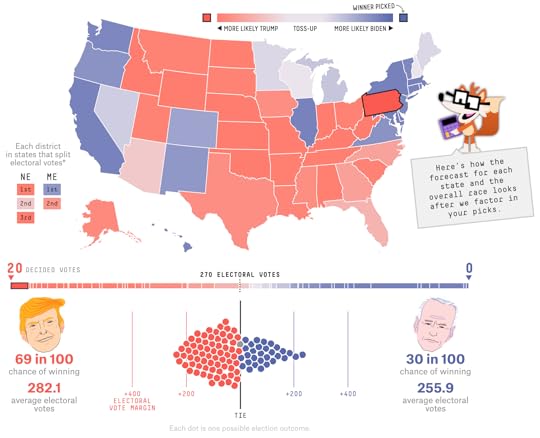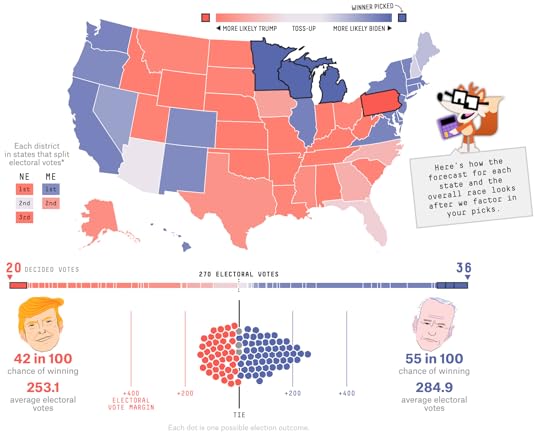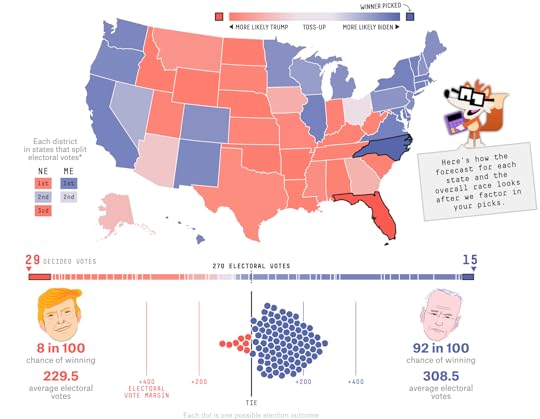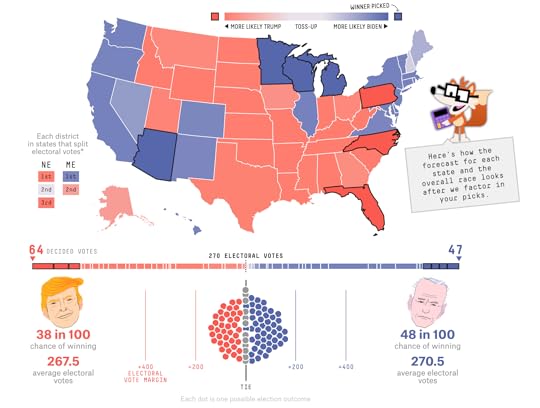Nate Silver's Blog, page 34
October 27, 2020
Is Joe Biden Toast If He Loses Pennsylvania?
Michigan and Wisconsin have been the focus of a lot of attention from nervous Democrats for the past four years, in part because Hillary Clinton spent relatively little time there and lost both states in 2016. So if you told Democrats that Joe Biden would be up by 7 points in Wisconsin and 8 points in Michigan in polls with a week to go, they’d feel …
Actually, who are we kidding? They’d still feel pretty nervous since the polls underestimated Donald Trump in these states four years ago! With that said, one key observation is that Biden could withstand 2016-style polling errors in those states and still win. (Clinton led by 4 points in Michigan and 5 points in Wisconsin in our final polling averages in those states in 2016, and then lost both states by less than one point. But Biden’s extra cushion means he could survive a 2016-magnitude miss.)
The polls have been tighter in Pennsylvania, though. Biden’s current lead is just 5.1 points, and in 2016, polls were off by 4.4 points in the Keystone State — Trump won it by 0.7 points after trailing in our final polling average by 3.7 points there. So with a 2016-style polling error in Pennsylvania, Biden would be cutting it awfully close, perhaps even so close that court rulings on factors like “naked ballots” could swing the outcome.
Whether it makes sense that Biden is polling worse in Pennsylvania than in Michigan and Wisconsin is a fair question. Biden was born in Scranton, and it’s the most urban and racially diverse of the three states. Still, Wisconsin and Michigan are traditionally more Democratic; Barack Obama won them by larger margins than Pennsylvania in 2012, for instance. So maybe there’s been some reversion to the mean here. In any event, the polling has been consistent enough in showing Pennsylvania tighter than Michigan and Wisconsin that we probably need to take it at face value at this stage.
So here’s a question we can ask with our nifty scenario generator. Is Pennsylvania a must-win for Biden?
No, not quite. It is close to being a must-win for Trump, who has only a 2 percent chance of winning the Electoral College if he loses Pennsylvania. Biden, however, has a bit more margin for error. He’d have a 30 percent chance if he lost Pennsylvania, which isn’t great but is also higher than, say, Trump’s overall chances on Election Day 2016.
 [image error]
[image error]
The reason losing Pennsylvania wouldn’t necessarily doom Biden is because he could still hold those other Midwestern/Rust Belt states. Pennsylvania is fairly similar to Michigan and Wisconsin, but not that similar. As I mentioned, it’s denser and more racially diverse. It may or may not be in the Midwest. It’s traditionally a bit more purple. So if Biden is doing better than Clinton with rural whites but worse with Black voters — as a lot of polling shows — he might gain ground in Wisconsin but lose in Pennsylvania.
Say, then, that Biden loses Pennsylvania but wins Michigan and Wisconsin. For good measure, we’ll also give Minnesota to Biden. What do his chances look like then? Biden’s actually a slight favorite (55 percent) in this scenario.
 [image error]
[image error]
This map has a lot of interesting aspects that give you some hints about how our model works behind the scenes. Here, for instance, are Biden’s chances of winning other swing states if he loses Pennsylvania but wins the other three Midwestern states:
What Biden’s chances would look like after a Rust Belt split
Biden’s chances of winning each swing state in FiveThirtyEight’s presidential forecast, as of 5:30 a.m. on Oct. 27
Biden chances of victory
State
Initial
chances
PA Loss,
WI, MI, MN Win
Virginia
99%
99%
New Mexico
97
96
Colorado
96
95
Nevada
91
86
Maine
90
73
New Hampshire
87
65
Arizona
66
49
Florida
66
37
North Carolina
65
24
Georgia
46
22
Iowa
50
16
Ohio
42
3
Texas
33
10
The biggest decline to Biden’s chances comes in Ohio. That makes sense. It’s not an easy state for him to win anyway, and it should be highly correlated with Pennsylvania, so if he can’t win in Pennsylvania, it’s very hard to imagine him winning there. Iowa is a bit more viable for Biden because it’s more similar to Wisconsin and Minnesota than to Pennsylvania, but it would still be a long shot.
The model also thinks New Hampshire and Maine could be problems for Biden if he loses Pennsylvania, although he’d still be favored in those states. Demographically, Maine is more similar to Wisconsin than it is to Pennsylvania — it’s white and rural. But geographically, it’s closer to Pennsylvania. Our model considers both factors, as geography can often be a proxy for lots of hidden factors that cause correlated outcomes between states but are otherwise hard to detect.
Conversely, what happens in the Rust Belt doesn’t tell us much about what will happen in Nevada, Colorado or New Mexico — those groups of states just aren’t that similar.
Biden’s chances would decline in Florida, Arizona, North Carolina, Georgia and Texas, however. Part of that is because these states just aren’t that easy for a Democrat to win, period. So if Biden is having a mixed night — as evidenced by his losing Pennsylvania even if he wins Wisconsin and Michigan — they could be fairly heavy lifts.
In addition, these states do have some things in common with Pennsylvania. Florida, like Pennsylvania, has a fairly old electorate. North Carolina has a similar racial mix to Pennsylvania. And all of these states are middle-income with many transplants from Pennsylvania and the Midwest.
Still, Biden would be slightly favored to eke out a win in this scenario by winning one more of those Sunbelt states. The most likely would be Arizona, which has less in common with Pennsylvania than the others.
Biden’s work wouldn’t quite be done if he won Arizona, though. Rather, his chances would be 85 percent, with a 5 percent chance of a 269-269 tie. But he’d be in pretty good shape. He could hold the other states Clinton won in 2016 and then flip either Iowa or a congressional district in either Maine or Nebraska, which award one electoral vote each. Alternatively, he could even lose another state Clinton won, like Maine or New Hampshire, if he carried a second Sunbelt state such as Georgia.
We’re getting into the weeds. But here’s the thing: Yes, Biden and Democrats should be nervous that he has only about a 5-point lead in Pennsylvania, the most likely tipping point state. Five points is more than a normal-sized polling error, but not that much more. And Biden does have some backup plans. A regional polling error in the Midwest or the Northeast wouldn’t necessarily doom his chances in states like Arizona, for instance. It wouldn’t be the blowout that Democrats hope for, but Biden would still retain an edge in the Electoral College even without winning his birth state.
October 26, 2020
Surprise! October Surprises Don’t Usually Decide Elections
In this installment of the FiveThirtyEight Politics podcast, the crew discusses the October surprises we’ve seen so far this year and the likelihood of another late development shaking up the race for president. The gang also answers more listener questions.
Politics Podcast: Could Any Surprises Still Affect The Race For President?
More: Apple Podcasts |
ESPN App |
RSS
Election Day is just eight days away, and more than 60 million Americans have already voted — that’s about 45 percent of all the votes counted in 2016. So could any new developments still affect the race? In this installment of the FiveThirtyEight Politics podcast, the crew looks at how October surprises have — or haven’t — shaped past elections and what issues are driving the final days of the 2020 campaign. They also shake out the mailbag and answer some listener questions.
You can listen to the episode by clicking the “play” button in the audio player above or by downloading it in iTunes , the ESPN App or your favorite podcast platform. If you are new to podcasts, learn how to listen .
The FiveThirtyEight Politics podcast is recorded Mondays and Thursdays. Help new listeners discover the show by leaving us a rating and review on iTunes . Have a comment, question or suggestion for “good polling vs. bad polling”? Get in touch by email, on Twitter or in the comments.
October 23, 2020
Will A Runoff In Georgia Decide Control Of The Senate? And Other Listener Questions.
In this installment of Model Talk on the FiveThirtyEight Politics podcast, editor-in-chief Nate Silver talks to Galen Druke about why state-level and national polls are showing different degrees of competitiveness. They also answer more listener questions.
Politics Podcast: National And District-Level Polls Disagree About How Close The 2020 Election Is
More: Apple Podcasts |
ESPN App |
RSS
Our national polling average shows Joe Biden with about a 10-point lead, while the state-level polls indicate his lead is closer to 8 points. Meanwhile, some recent polling in congressional districts shows margins for Biden that suggest he’s leading by more than 10 points nationally. In this installment of Model Talk on the FiveThirtyEight Politics podcast, editor-in-chief Nate Silver talks to Galen Druke about why those polls are showing different degrees of competitiveness. They also answer listener questions including, How long did it take to build the forecast? And what’s the chance of a Georgia runoff deciding who controls the Senate?
You can listen to the episode by clicking the “play” button in the audio player above or by downloading it in iTunes , the ESPN App or your favorite podcast platform. If you are new to podcasts, learn how to listen .
The FiveThirtyEight Politics podcast is recorded Mondays and Thursdays. Help new listeners discover the show by leaving us a rating and review on iTunes . Have a comment, question or suggestion for “good polling vs. bad polling”? Get in touch by email, on Twitter or in the comments.
Will The Race Tighten After The Final Debate?
In this installment of the FiveThirtyEight Politics podcast, the crew recaps the final presidential debate and considers what the rest of the 2020 campaign will look like.
Politics Podcast: The Last Debate Is Over And The Final Stage Of The Campaign Has Begun
More: Apple Podcasts |
ESPN App |
RSS
Now that the last presidential debate is over, there are no major set pieces remaining in the 2020 campaign. In this installment of the FiveThirtyEight Politics podcast, the crew reviews what happened in the debate and considers what the rest of the campaign could hold in store.
October 21, 2020
We’re Letting You Mess With Our Presidential Forecast, But Try Not To Make The Map Too Weird
The 2020 election might feel like either a dream or a nightmare, depending on who you’re rooting for. But with our new interactive, you’ll at least be able to choose your own election adventure and explore how winning a state or a combination of states will affect President Trump’s and Joe Biden’s chances of winning the Electoral College.
When you first open the interactive, it’ll show you a map that’s shaded based on our presidential forecast and the 40,000 simulations we run each time we update the model. Deep-blue California, for example, is almost certain to go to Biden, while Trump is favored but not a lock in light-red Texas given their current odds. But what happens if, say, Trump gets some swing states called for him on Nov. 3? How might the probabilities change? That’s what this interactive is all about.
Unlike other tools that explore paths to 270 electoral votes — many of which are very cool and we like a lot! — ours focuses specifically on how the states are related to one another. Click on Kentucky to turn it red, for instance, and the forecast barely budges, since Trump is almost certain to win Kentucky anyway, and that assumption is already built into the forecast.
Upset wins or decisions in states that our model considers toss-ups could matter a lot more, though. If Biden wins Florida, for instance, his chances1 of winning the Electoral College shoot up to greater than 99 percent, which could be important on Nov. 3 because Florida generally counts its votes quickly and the networks might be able to determine who won the state on election night. But if Trump wins Florida, his Electoral College chances rise to 39 percent, making the race practically a toss-up.
Why such big swings based on just one state? It’s not simply that Florida’s 29 electoral votes are valuable, although they are. It’s also that Florida provides an indication of how other states might vote. Polling errors are correlated, so if Trump wins Florida — where he’s slightly behind right now — he could beat his polls in other states too.
You can also look at how states behave in combination with one another, according to our forecast. Say that Trump wins Florida but that Biden wins North Carolina, another state that usually tallies its votes quickly. This is a good trade for Biden, on balance. His projected number of electoral votes declines from our initial forecast — he’s averaging 345 electoral votes in our forecast as of Tuesday afternoon, and he’d drop to around 309 in this scenario — because without Florida, he won’t have any sort of runaway, landslide victory. But Biden’s probability of winning some combination of 270 electoral votes and therefore the Electoral College increases to 92 percent if he loses Florida but wins North Carolina, because it’s hard for Trump to win the Electoral College unless he wins both states.

In general, Biden has more paths to 270 than Trump, which reflects the fact that he has the polling lead in most swing states. But problems in the Upper Midwest could spell trouble for Biden, as it did for Hillary Clinton in 2016. Trump has a 75 percent chance of winning the election if he wins Wisconsin, for instance.
Another “fun” challenge is to seek out scenarios that could produce a 269-269 Electoral College tie. For instance, if Trump wins Florida, Pennsylvania and North Carolina but Biden wins Michigan, Wisconsin, Minnesota and Arizona, then we wind up with a tie about 12 percent of the time. And before you ask, yes: The interactive does let you choose the winners of each congressional district in Nebraska and Maine, states that give one of their electoral votes to the winner of each district — those single votes are sometimes important in breaking ties.

Our simulations also reflect that states that are more geographically and demographically similar are more likely to swing in the same direction. If Trump wins both North Carolina and Florida, for instance, then Biden’s chances of winning neighboring Georgia fall to just 4 percent. If Biden wins North Carolina and Florida, though, his chances in Georgia soar to 74 percent. By contrast, the candidates’ chances of winning Montana don’t go up or down much based on what you tell the interactive to do in Florida and North Carolina because Montana is so dissimilar to them.
But we’d encourage you to stick to relatively realistic scenarios. The interactive will allow you to do weird things, but only up to a point. Namely, it won’t let you call a state for a candidate if he has less than a 1.5 percent chance of winning it in our initial forecast. But say you want to see what happens if Biden wins Ohio but loses Michigan. You can test that, but be warned: Although both Ohio and Michigan are competitive, that combination of outcomes is rare, since Ohio and Michigan are similar states but Michigan is usually much bluer.
The model will still spit out an answer, but it’s hard to know how reliable it will be — very few of the 40,000 simulations we run in our forecast will have Biden winning Ohio but Trump winning Michigan. In cases like this where there are few simulations that match the map you’ve chosen, the interactive instead uses a regression-based technique and essentially runs some new simulations on the fly. Still, that could lead to a “garbage in, garbage out” problem.
The goal of our forecast is to figure out which scenarios are most plausible in the real world, and if you deliberately choose some implausible ones, it may be hard to know what to make of the output. Overall, though, we hope you’ll find the interactive both fun and informative — and if you’ve got any questions, please don’t hesitate to drop us a line.
October 19, 2020
What Full Democratic Control Of The White House And Congress Would Look Like
In this episode of the FiveThirtyEight Politics podcast, the crew compares Joe Biden’s lead now with Hillary Clinton’s in 2016 and considers the agenda Democrats might pursue if they win the presidency, House and Senate in November.
Nate Silver's Blog
- Nate Silver's profile
- 729 followers



